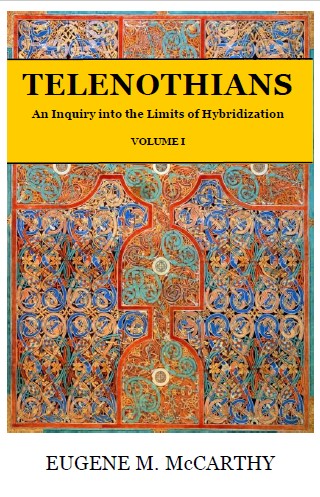Chicken-duck Hybrids
This page was a draft for a chapter of my book Telenothians, available here.
|
I believe, that two species widely different from each other, as water-fowl and land-birds, &c. cannot possibly conjoin, so as to produce a living mixed offspring.
|
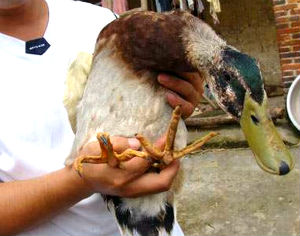 An ostensible chicken-duck-hybrid that made news in China in 2008. Note the chicken-like feet and mallard-like head. Enlarge image
An ostensible chicken-duck-hybrid that made news in China in 2008. Note the chicken-like feet and mallard-like head. Enlarge image
Annie P. Gray, author of the mid-twentieth century reference Bird Hybrids (1958), lists this cross (Gallus gallus × Anas platyrhynchos), but rejects its authenticity. After all, it involves members of two different avian orders (Galliformes and Anseriformes). But Gray was writing at a time when far less was known about animal hybrids, and she had no access to the powerful search engines of the modern internet. One can now find much more information about such animals than would have been possible in Gray’s day.
For example, a story, accompanied by photographs (see image at right above), circulated widely on the internet in 2008. It told of a Chinese farmer, Fu Haiwen, who had a duck with the feet of a chicken. “It never went with the other ducks to swim in the river,” he said, adding that it even seemed scared of water. Puzzled by its strange behavior, he picked it up and was surprised to see its feet lacked webbing. When his discovery became known, curious residents of his village (Huangjin in Xicheng) flocked to see the creature and its story hit the news. As can be seen in the photo, this literal rara avis had a mallard-like head, though the bill was green, not yellow. Its plumage from the neck down was more like that of a chicken.
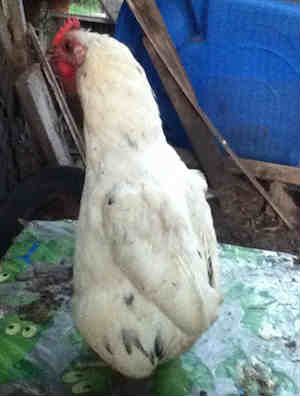 A bird hatched in Texas, “Chuck, the Chicken-duck,” differed substantially from the Chinese bird pictured above. A female, “Chuck” had chicken feet and head, but a duck-like body. According to her owner, this bird could float and swim like a duck. Notice her erect, duck-like posture. This strange creature is shown in the video above.
A bird hatched in Texas, “Chuck, the Chicken-duck,” differed substantially from the Chinese bird pictured above. A female, “Chuck” had chicken feet and head, but a duck-like body. According to her owner, this bird could float and swim like a duck. Notice her erect, duck-like posture. This strange creature is shown in the video above.
A second bird (image at right and video above), a female hatched here in the U.S., appeared in several news reports and is better documented than the Chinese specimen. Despite her sex, her owner dubbed her “Chuck the Chicken-duck” (from chicken + duck). Chuck not only had chicken-like feet, as did the alleged chicken-duck hybrid in China, but also differed substantially from the Chinese bird in having a chicken-like head. Nevertheless, as can clearly be seen in the picture at right and the video at the top of this page, she had a duck-like body. In the video her waddle and her erect posture, in particular, are quite strikingly reminiscent of a duck.
I contacted the bird’s owner, Ron Schneider, by phone (1/21/2016) in an attempt to obtain feathers for genetic testing to ascertain whether Chuck actually was a chicken-duck hybrid. Unfortunately, he informed me that she had been dead for two years. Schneider did, however, supply me with some additional information. He had originally gotten Chuck from a friend, he said, who kept ducks and chickens together in the same pen.
Schneider also told me that she could float and swim like a duck (unlike the Chinese bird discussed above). Chuck didn’t cackle or scratch like a chicken, he said, and her eggs never hatched (a fact consistent with the idea that she was a sterile hybrid). Indeed, they often exploded (as old, addled eggs often do, as gas pressure builds inside the shell). Individual eggs produced by this bird showed an unusual variation in pigmentation from one egg to another not seen in purebred birds.
In response to my request for feathers Schneider said he thought Chuck’s buried remains might still be available, which would have allowed testing. Unfortunately, as explained in the following quoted email, it turned out that that wouldn't be possible:
Chicken-duck Hybrids: News reports
Numerous cases of alleged chicken-duck hybrids reported in newspapers are cited on this page. However, some cases, such as the following, if honestly reported must necessarily refer to a bonafide cross between chicken and duck, due to the indubitably mixed characteristics it presented. The report appeared in many U.S. newspapers in 1919, but the following is taken from the Seattle, Washington, Star (Jun. 28, 1919, p. 13, col. 3):
HALF HEN, HALF DUCK
THIS ANIMAL GRUNTS
While the strange fowl is one year old it has never laid an egg. Sometimes it will fly to roost and again it will squat down and roost on the ground.
This report is of interest not only because, if true, it describes what must definitely have been a duck-chicken hybrid, but also because it is an example of an interesting condition sometimes seen in hybrids, that is, asymmetry with respect to the appendages, the presence of one chicken foot and one duck foot. Most hybrids are symmetrical even when their bodies are composed of what seem extremely disparate parts.
Another report, which again, if it was not a hoax, described a clear chicken-duck hybrid hatched from a duck egg. The story appeared in the Emporium, Pennsylvania, Cameron County Press (Aug. 18, 1904, p. 7, col. 4):
LOUISVILLE FOWL A FREAK
Has the Head of a Chicken and the
Body of a Duck and Quacks
and Cackles
Mr. Eilers is the proprietor of a grocery and saloon, and as a side issue is a chicken and dog fancier. He also has a number of ducks of the ordinary white variety, and it was one of these which hatched the freak fowl last summer. When the chicken-duck first appeared Mr. Eilers knew not what to do with it. He scarcely expected it to live on account of its deformities, but after a sickly week or two it began to grow and thrive, until it now weighs nearly six pounds. The bird was hatched from a duck’s egg, and for a week was cared for by a mother duck. The mother soon noticed the curious build of the fowl, however, and immediately disowned her offspring. Mr. Eilers then carefully cared for it until it was able to secure its own living among the chickens and ducks of his barn yard.
The head of the hybrid is as perfectly constructed as that of any chicken. The bill is slightly longer than that usually owned by chickens, but the head and comb are exact. The neck is long and carries the head erect, but at its base the resemblance to a chicken ceases entirely. The body is long and low and waddles about on a pair of short legs to which are appended webbed feet. The wings are large and capable of carrying the bird a considerable distance through the air. The fowl takes to water as readily as a duck, but eats everything peculiar to a chicken. Its voice is the most peculiar part about its make-up. At times the “quack! quack!” of a duck is heard all over the lot, and an instant later the “cackle! cackle!” of a chicken almost destroys the equilibrium of any curious observer.
Another, briefer report, which also must certainly describe a chicken-duck hybrid if true, appeared in the issue of the Freeland, Pennsylvania, Tribune (Oct. 17, 1889, p. 1, col. 1):
A Poultry Freak in Town
Another brief description of such a bird appeared in the Cobargo Chronicle (Feb. 17, 1917, p. 4, col. 1), a newspaper published in New South Wales, Australia:
Another report appeared that same year in the Lake City, Utah, Tribune (Mar. 23, 1904, p. 8):
THIS MAY BE A DUCK;
IT MAY BE A CHICKEN
The owner brought the fowl to the city yesterday in the hopes of having it exhibited by this State at the World’s Fair. Gov. Wells was not in his office, but Mr. Christensen was informed by Gen. Cannon secretary of the Utah commission, that the States are not making freak exhibits and that the bird would have to be displayed on the midway, where this State had nothing to say.
Another report about a chicken-duck hybrid appeared in the New York Sun (Aug. 22, 1897, sec. 3, p. 5, col. 4):
One of the Chickens is Half Duck
From the Pittsburgh DispatchThe freak is most awkward-looking thing. It stands erect, with its head high in the air, but when it starts to walk it has the “waddle” of the duck. The curiosity, which is a female, is now about six months old, and is in the best of health and spirits apparently, in spite of the fact that neither the other chickens nor ducks on Officer Snyder’s place will have anything to do with it socially.
A bird of almost identical description to the Allegheny bird was reported that same year of 1897, also in a New York City newspaper, The World (Jun. 6, 1897, p. 20; ||y5gqaezg). However, it must not have been the same individual, since the owner and locale differed.
DUCK WITH A HEN'S HEAD
Strange Freak of Nature in the
Barnyard of Constable Hock
The freak is about eight inches hight, a foot long, and a month old. It waddles around duck fashion on web feet, and looks at you out of hen's eyes set in a perfect hen's head, resting o a hen's neck. The bird's body is white, and its head and neck mottled gray, like that of an ordinary barnyard hen.
Hock has refused an offer of $150 from dime museum manager of New York City, and says if it is worth $150 to them, it is wo6th $200 to him, and that he will keep it as a curiosity.
A notice appeared in the Marshalltown, Iowa, Evening Times-Republican (Jan. 23, 1918, p. 3, col. 2):
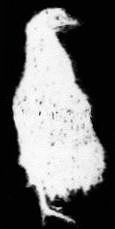
Another report about a chicken-duck hybrid appeared in many newspapers around the U.S. The original source of the report was the New York Herald, but the story quoted here, as well as the crude image shown at right, are from the Tucumcari, New Mexico, News (May 5, 1906, p. 2, col. 4):
Half Hen and Half Duck
The following report is from of the Tacoma, Washington, Times (Apr. 11, 1913, p. 4). This bird, like the Willimantic bird, seems similar to “Chuck,” the alleged Texas chicken-duck.
HALF CHICKEN HALF DUCK
Another report appeared in the Waco, Texas, Evening News (Jan. 17, 1889, p. 1, col. 5). This story, originating from the Atlanta Constitution, appeared in many papers around the U.S. Henry C. Hamilton of Dalton, Georgia, served as Clerk of the United States Court for the Northern District of Georgia.
HALF CHICKEN HALF DUCK
The mugwump is about the size of a frying size chicken. It is of the feminine gender. The head and breast are built like a hen, and the back, tail and legs are formed like those of a duck. But, strange to say, the creature is not webfooted. The fowl mugwump cackles like a hen, and in walking wabbles like a duck. Mr. Hamilton says that he was in Dalton Sunday and spent an hour looking at the freak. He says that it is the funniest thing he ever saw in a barnyard.—Atlanta Constitution.
A mugwump was a person who abandoned his political party to become an independent.
So in the twelve cases just cited, we have two individuals with a duckbill, and ten with a beak like a chicken’s. This small sample suggests that in this cross chicken traits tend to predominate in the anterior portion of the body, and duck traits posteriorly.
Several other alleged chicken-duck hybrids are described in the reports quoted below, but it seems only one of these, that reported by Schöpf, had an unmixed beak or a bill (its head was like a chicken’s). All the others had mandibles intermediate between those of chickens and ducks. So it seems these hybrids, if they actually were hybrids, and if they truly were as described, were quite variable even though they were, presumably, the products of a first cross (F₁ hybrids). In less disparate crosses, F₁ hybrids are generally rather uniform, showing little variation from one individual to another.
The next report, if accurate, describes a great rarity, a chicken-duck hybrid that was also a conjoined twin. It appeared in the Washington, D.C. TTimes (Apr. 20, 1894, p. 3, col. 5):
Nicholas Van Pelt’s Curiosity
A second case of asymmetry, a chicken-duck hybrid with one chicken foot and one duck foot is briefly described in an Australian report, which appeared in the Coffs Harbour, New South Wales, Advocate (Feb. 5, 1935, p. 2):
FREAK DUCKLING
Another Australian report about a chicken-duck with webbed feet waddled into Sydney, New South Wales, Farmer and Settler (Oct. 7, 1937, p. 3):
Web-Footed Chicken
Note, however, that a single gene being blocked can produce webbed feet in chickens, as shown by Zou and Niswander (1996). So no bird should be diagnosed as a chicken-duck hybrid solely on the basis of its having webbed feet. Rather it should have multiple traits of both chickens and ducks.
But given available information, it does seem probable that chicken-duck hybrids, though quite rare, do exist. This possibility is consistent with the fact that in certain distant crosses involving domestic poultry, such as quail-chicken, turkey-chicken or capercaillie-chicken, thousands of inseminations may be needed to produce just a few mature hybrids (McCarthy 2006).
Mating between chickens and ducks Before going further, it should perhaps be pointed out that chickens do often mate with ducks, as is amply documented on YouTube. Although many city dwellers may be surprised by this fact, such behavior has been observed in the farmyard for centuries. An early report about a duck mating with a chicken was given by the eighteenth-century French scientist René-Antoine Ferchault de Réaumur (1750), who describes such a case.
An early report of hybrids being produced from matings between a female duck and a rooster also dates to the eighteenth century. The German naturalist Johann Taube (1727-1799) was physician to the British court and to the court of Brunswick-Lüneburg. He was also the author of a collection of articles on the natural history of Celle (Beiträge zur Naturkunde des Herzogthums Zelle, 1766-1769, Zelle, Johann Dieterich Schulze), a duchy in northern Germany. The following is excerpted from an essay in that publication entitled “Bemerkung von einer Hühner-Endte” (“Comments on a Hen-Duck,” vol. 1, pp. 257-259). “A female duck living alone in a barnyard with the chickens was unable to avoid an aggressive rooster there, and was many times subjected to his advances. When she then brooded, she brought into
For more details about this same case see: Mannigfaltigkeiten: eine gemeinnützige Wochenschrift, 1771, pp. 600-604.
In his account of his travels through early America during the years 1783-1784, the German botanist, zoologist, and physician, Johann David Schöpf mentions (Schöpf 1788, p. 138) that while in Philadelphia he saw a chicken-duck hybrid at the home of a certain D. Glentworth. Thus, he writes, “At this gentleman’s home I encountered another remarkable phenomenon, which
The German-language magazine Jurende’s vaterländischer Pilger (1828, vol. 15, p. 374, #19) reports a duck on an Austrian farm who flocked with chickens by preference and who mated with a rooster (probably, she had been hatched under a hen and was imprinted on chickens). She produced seven mixed offspring who looked mostly like a duck, but without webbed feet and with a mandible that was a duckbill in its lower part, but a chicken beak in its upper. These birds, like those described with a similar bill structure elsewhere on this page, could not pick up individual kernels of grain and, so, had to be given their food in heaps (e.g., compare the report of Biggs, quoted at left). According to the account, all but two of these birds drowned trying to forage for food in water.
There are at least two other eyewitness reports by scholars. In the first, a letter to Magazine of Natural History (Biggs 1834, p. 516) with the lengthy title “Ducks with the toes not connected by a web or membrane, and the upper mandible imperfect: presumed to have proceeded from a union between the domestic duck and domestic fowl,” Arthur Biggs (1765-1848), a fellow of the Linnean Society of London and for many years Curator of the Cambridge University Botanic Garden, describes three alleged hybrids:
|
(1815-1883) (1816-1888) |
In another report (Peters 1862), the German zoologist, anatomist, and explorer Wilhelm Carl Hartwig Peters (1815-1883) communicated to Journal für Ornithologie, a letter from Dr. Anton Sommer (1816-1888), a resident of Rudolstadt in Thuringia. Sommer, a well-known author, was founder and headmaster of a school in that town. Peters was a professor at Berlin University (Berliner Universität, the precursor of today’s Humboldt-Universität zu Berlin). The latter was also the director of the university’s zoological museum. At the time he communicated Sommer’s letter, Peters was also director of the Berlin Zoological Gardens. He provides the following introduction to Sommer’s letter. “Last autumn, when I had the pleasure of spending some time with
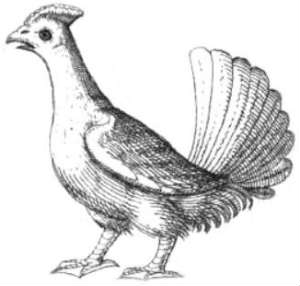 An early illustration of a chicken with webbed feet (Schenck, Monstrorum historia memorabilis, 1609, p. 124, fig. 94).
An early illustration of a chicken with webbed feet (Schenck, Monstrorum historia memorabilis, 1609, p. 124, fig. 94).
In his letter, Sommer describes a bird he believed to be a hybrid between a chicken and a duck, which he says he “saw in the late twenties at the mill at Oeblitz, about halfway between [the cities of] Naumburg and Weissenfels, across [the river Saale] from [the municipality of] Goseck. It was here that I spent most of my school holidays. In the barnyard there,
|
Above all things is the behavior of a hen when ducks’ eggs have been put under her and have hatched out—first her surprise when she does not quite recognize her brood, then her puzzled sobs as she anxiously calls them, and finally her lamentations around the margin of the pond when her young ones under the guidance of instinct take to the water.
—Pliny the Elder The Natural History, Book X, lxxvi, 155 |
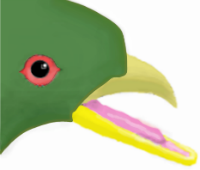 A reconstruction of the beak of a chicken-duck hybrid based on two of the quoted historical reports. The upper mandible is chicken-like, the lower, like the bill of a duck. However, when considered as a whole, the few reports available suggest a high level of variability in this cross, even in the F₁ generation, with some individuals having bills like ducks, and others, beaks like chickens, but with others having a mandibular structure somewhere in between.
A reconstruction of the beak of a chicken-duck hybrid based on two of the quoted historical reports. The upper mandible is chicken-like, the lower, like the bill of a duck. However, when considered as a whole, the few reports available suggest a high level of variability in this cross, even in the F₁ generation, with some individuals having bills like ducks, and others, beaks like chickens, but with others having a mandibular structure somewhere in between.
Sommer was then in his early teens. He goes on to say that after returning to his home in Rudolstadt he came to the realization that he could repeat the experiment with birds from his parents’ flock. He intentionally imprinted cocks on ducks, he says, by placing duck eggs under hens so that they would raise the ducklings when they hatched. As he, continuing, explains, “Naturally, I could not rest after this, and I wanted to do intentionally, what had first occurred by chance. Already, I held in my hand the thread that would lead me to this goal, that is, I had observed that a drake, which had hatched under a hen, was always chasing hot after our chickens. I therefore caused cocks to be brooded under ducks and perceived already
A very early case. The German physician Christian Franz Paullini (1686) communicated an abridgement of a manuscript compilation of curiosities collected by the monks Isibordus von Amelunxen and Alexander Insulanus at the Imperial Abbey of Corvey around 1200 A.D. In Observation XXXVI (Paullini 1686, p. 204) of that compilation, Insulanus states that in the year 1176, at Blankenau, a town near the abbey, "Our estate manager reared a drake who frequently mounted hens. This bird, together with one of the hens, produced some chicks who were truly part chicken, but who had the bill and feet of a duck. They were lovely, amphibious little monsters." (See also: Isensee 1843, p. 287)
And your mother were a duck,
Would you be a dicken?
Or would you be a chuck?
Duck-hen’s somewhat clearer,
But hen-duck seems good, too,
For a duck who’s nearer
Chicken than a duck who’s true.
Another interordinal avian cross >>
Human Origins: Are We Hybrid? >>
Note: Mylius (1751, pp. 392-394, 627-628) also briefly describes some chicken-duck hybrids.
Note: An old French name for chicken-duck hybrids is gélinottes d'eau, which roughly translates as “water grouse.”
Chicken-duck hybrids - © Macroevolution.net
References:
Ackermann, K. 1898. Thierbastarde. Zusammenstellung der bisherigen Beobachtungen über Bastardirung im Thierreiche nebst Litteraturnachweisen. II: Die Wirbelthiere. Kassel: Weber und Weidemeyer.
Bechstein, J. M. 1791. Gemeinnützige Naturgeschichte Deutschlands nach allen drey Reichen: Ein Handbuch zur deutlichern und vollständigern Selbstbelehrung besonders für Forstmänner, Jugendlehrer und Oekonomen, vol. 2. Leipzig: Siegfried Lebrecht Crusius, http://tinyurl.com/cwys32f (p. 719).
Bechstein, J. M. 1793. Gemeinnützige Naturgeschichte Deutschlands nach allen drey Reichen: Ein Handbuch zur deutlichern und vollständigern Selbstbelehrung besonders für Forstmänner, Jugendlehrer und Oekonomen, vol. 3. Leipzig: Siegfried Lebrecht Crusius (p. 411).
Biggs, A. 1834. Ducks with the toes not connected by a web or membrane, and the upper mandible imperfect: presumed to have proceeded from a union between the domestic duck and domestic fowl. Magazine of Natural History and Journal of Zoology, Botany, Mineralogy, Geology and Meteorology. 7: 516-517.
Bronn, H. G. 1847. Handbuch einer Geschichte der Natur. Vol. 2, 2nd ed. Stuttgart, Wien, http://tinyurl.com/br9jpg2 (pp. 165, 174).
Gray, A. P. 1958. Bird hybrids: A checklist with bibliography. Commonwealth Agricultural Bureaux, The Commonwealth Bureau of Animal Breeding and Genetics Edinburgh, Farnham Royal, Bucks, England.
Mylius, C. 1751. Physikalische Belustigungen, vol. 1. Berlin: Christian Friedrich Voß.
Peters, W. 1862. Ueber Bastardbildung von Rector Dr. Sommer, in Schnepfenthal. Journal für Ornithologie. 10: 209-212.
Przibram, H. 1910. Experimentalzoologie. 3. Phylogenese. Chapter IV: Bastardierung. Leipzig and Vienna: Franz Deuticke, (p. 80).
Shufeldt, R. W. 1893. Notes on the trunk skeleton of a hybrid grouse. The Auk, 10: 281-285. http://tinyurl.com/pnhyffm (On p. 282, Shufeldt describes mating between a drake and a hen.)
Taube, J. 1766. Beyträge zur Naturkunde des Herzogthums Zelle. vol. 1. Zelle: Johann Dieterich Schulze. http://tinyurl.com/cmfzztb).
von Haller, A. 1758. Sur la formation du coeur dans le poulet, sur l'oeil, sur la structure du ... second mémoire. Lausanne, Bousquet. http://tinyurl.com/chzk6jy (p. 189).
Most shared on Macroevolution.net:
Human Origins: Are we hybrids?
On the Origins of New Forms of Life
Mammalian Hybrids
Cat-rabbit Hybrids: Fact or fiction?
Famous Biologists
Dog-cow Hybrids
Prothero: A Rebuttal
Branches of Biology
Dog-fox Hybrids
